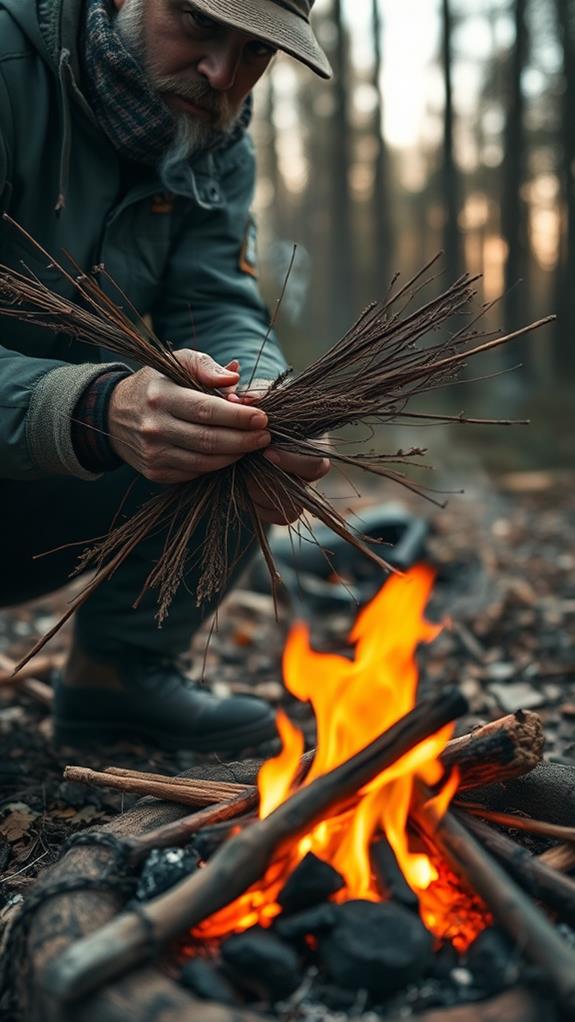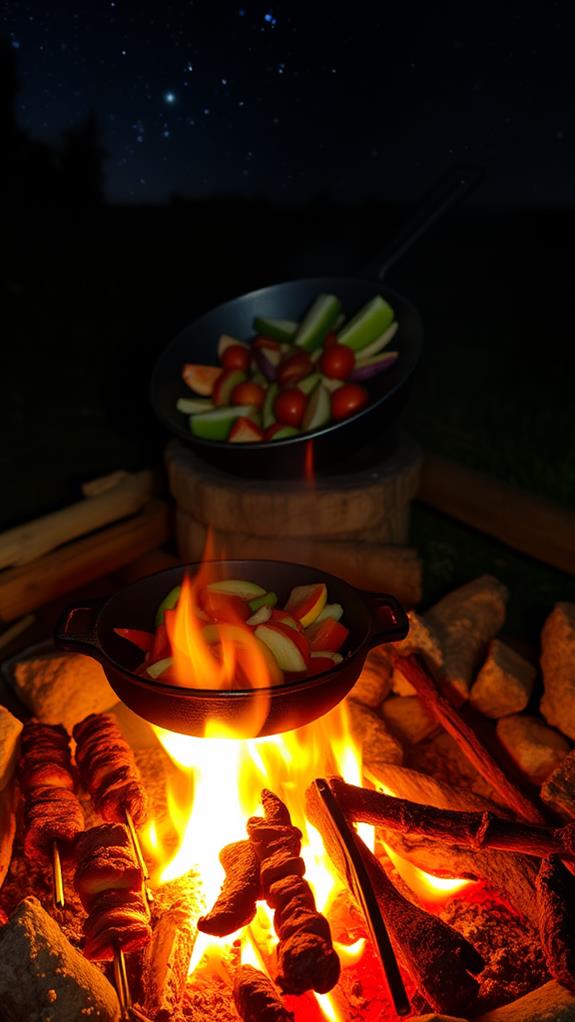Mastering fire is an essential skill for your survival and resilience in the great outdoors. It offers warmth, allows you to cook food, and can even provide protection. Start by selecting quality tinder and gathering wood of varying sizes. You can use techniques like hand or bow drills to create ember and ignite your fire. Once you’ve got that coal glowing, nurture it with gentle breath and build a sturdy structure for strong flames. Practicing these methods not only builds your confidence but also connects you to ancient skills. Keep exploring to enhance your fire expertise even further!
Quick Facts
- Mastering fire-making techniques, such as hand and bow drills, connects you with ancestral skills and enhances survival resilience.
- Understanding essential fire preparation steps ensures effective ignition and control over flames for warmth and cooking.
- Effective fire building methods, like the teepee or log cabin, optimize airflow and maintain a sustainable heat source.
- Cooking over fire enhances flavor and nutrition, offering a practical skill for survival while fostering community through shared meals.
- Prioritizing fire safety and responsible practices protects the environment and ensures safe outdoor experiences.
Significance of Fire in Survival
Fire is an essential lifeline in survival situations, converting mere existence into a thriving experience. Its cultural significance runs deep, connecting you to historical practices that have shaped human existence.
Think about our ancestors who relied on fire not just for warmth, but for cooking and protection. When you master fire-making, you tap into a legacy of resilience and self-sufficiency.
You’re not just lighting a flame; you’re igniting a crucial skill that enhances your connection to nature and your heritage. Imagine gathering with others around a fire, sharing stories of survival and strength.
Embracing fire in your life means embracing the freedom to thrive, to innovate, and to honor the traditions that have kept humanity alive for millennia.
Essential Fire Preparation Steps

Often overlooked, proper preparation is crucial for successfully starting a fire. Begin by selecting quality tinder—think dry leaves, grass, or birch bark. Clear a space, exposing mineral soil, and gather your wood in sizes from smallest to largest. When transferring an ember, use a stick to hold it steady and place it gently onto your tinder.
Here’s a quick reference table for your fire preparation:
| Step | Action | Purpose |
|---|---|---|
| Tinder Selection | Choose dry, flammable materials | Guarantees initial ignition |
| Wood Sorting | Organize from smallest to largest | Builds fire strength gradually |
| Ember Transfer | Use a stick to hold ember | Prevents losing the coal |
| Clear Ground | Remove debris to expose soil | Reduces fire risk |
| Airflow Management | Arrange wood with gaps | Enhances combustion |
With these steps, you’re on your way to mastering fire!
Techniques for Hand and Bow Drills

Mastering the art of creating fire through hand and bow drills can feel like releasing a primal skill that connects you to our ancestors.
By understanding hand drill techniques and bow drill efficiency, you can ignite your passion for survival.
Here are three key steps to get started:
- Choose the Right Materials: Use a dry, non-resinous wood for the hearth board and a straight, soft spindle for optimal friction.
- Prepare Your Hearth Board: Create a divot for the spindle and a notch for collecting dust, which will eventually turn to coal.
- Practice Consistency: Apply steady pressure and maintain a smooth rotation with the bow to maximize speed and efficiency.
With practice, you’ll find the rhythm that brings forth fire, embracing your inner expert!
Creating Coal and Flames

Once you’ve successfully created friction with your hand or bow drill, the next challenge is converting that initial ember into a lively flame.
First, you’ll want to nurture your ember by gently blowing on it to increase oxygen flow—this is essential for coal maintenance.
Once your coal glows, carefully transfer it to a tinder bundle. Form a teepee with the smallest twigs around the coal, gradually introducing larger pieces as the flame grows.
Keep a close eye on your flame management; adjusting the wood placement allows for optimal airflow, ensuring your fire remains strong.
Effective Fire Building Methods

Building an effective fire is essential for outdoor survival and can greatly enhance your camping experience. Mastering fire building techniques not only warms you but also fuels your spirit of exploration.
Here are three methods to consider:
- Teepee Fire: Arrange small twigs in a cone shape. This maximizes airflow, ensuring quick ignition and strong flames.
- Parallel Log Method: Lay logs side by side with air gaps in between. This method generates a steady bed of coals, perfect for cooking.
- Log Cabin Fire: Stack logs in a square formation, allowing airflow while creating a compact, controlled fire.
Always prioritize fire safety and adopt sustainable practices to protect the environment while enjoying the freedom of the great outdoors.
Cooking Over Fire Techniques

Cooking over an open fire alters your outdoor meals into a memorable experience filled with flavor and warmth.
Welcome different cooking techniques like grilling over hot coals or using a spit for roasting. Always prioritize fire safety—keep water nearby to douse any unexpected flames and never leave your fire unattended.
Start with smaller pieces of wood to create a strong base of coals, then layer larger logs as the fire grows. If you’re cooking meat, place it directly on the coals for that irresistible smoky flavor.
For veggies, consider using a grill grate or wrapping them in foil. With practice, you’ll excel in these techniques, turning every meal into an escapade that connects you with nature.
Conclusion
As you plunge into perfecting fire, remember that it’s not just a survival skill; it’s a connection to our ancestors. Did you know that nearly 90% of human history relied on fire for warmth, cooking, and protection? By honing your fire-making abilities, you’re joining a lineage of resilient individuals. So, gather your materials, practice those techniques, and feel the satisfaction of creating something so essential. Welcome the flame and let it ignite your expedition toward self-sufficiency!

